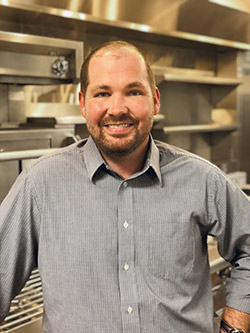Bobby Clay was at the University of New Orleans studying mechanical engineering when Hurricane Katrina hit and put a big wrench in his career plans. “That ended my tenure at the university pretty quickly, and I ended up joining the workforce in residential construction,” he says.
 Bobby Clay Clay quickly moved up the ranks into project management. He then worked in sales, focusing on outdoor kitchens, before joining NOLA Restaurant Supply and Design about four years ago as project manager for commercial kitchens. He has since transitioned over to the design and specification side, negotiating sales.
Bobby Clay Clay quickly moved up the ranks into project management. He then worked in sales, focusing on outdoor kitchens, before joining NOLA Restaurant Supply and Design about four years ago as project manager for commercial kitchens. He has since transitioned over to the design and specification side, negotiating sales.
“I had a strong background in how a kitchen should operate because in college I worked at Acme Oyster House as a cook and waiter,” Clay says. “I knew my way around a kitchen, how equipment worked, etc.”
FE&S: What does a well-designed commercial kitchen look like to you?
BC: I am a huge fan of efficiency. Every aspect, from how many steps it takes cooks to execute menu items to prep to servers in the front of the house, having things flow as efficiently as possible is key. When we work with large hotels especially, it is helpful to have an efficient layout and equipment that helps minimize labor to save money. We work with many cramped spaces in the French Quarter and have to be real creative in terms of the equipment to maximize space. We need to make sure that even if a kitchen is 210 square feet, it can produce for a 180-seat restaurant. It’s all about helping the operator execute the menu as quickly as possible.
FE&S: What goes into writing a good equipment spec?
BC: In my opinion, we need to identify the correct piece of equipment for the operator. It needs to be sized appropriately for the menu and seating. We strive to specify the correct piece and still allow for flexibility in the future. Menus are ever evolving so we need to allow for changes to be implemented.
FE&S: What’s your secret to keeping track of all the details with a project?
BC: My secret is to start the work day early. My day starts way before phones are ringing and emails arrive. I also keep morning notes for issues I need resolved that day and that week, and make sure before the workday starts I’m getting questions answered or issues resolved.
FE&S: How do you build consensus among all the stakeholders on a project?
BC: Many times, I will consult with end users or operators, doing an initial consultation to identify their needs. We’ll spitball ideas and come up with an initial game plan, then get factory reps involved and work with them hand in hand. I’ll bring reps to meet end users if their equipment looks to be the answer, which gives more validity to what I tell them.
FE&S: What excites you about the future of the foodservice industry?
BC: I’m an advocate for innovation, and I love the new technology coming out. I went to school for mechanical engineering, so I always want to know how something works. I’m very interested in the details of the equipment to better advise my customers.



